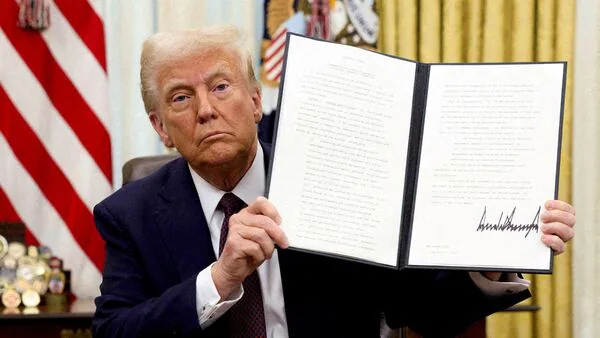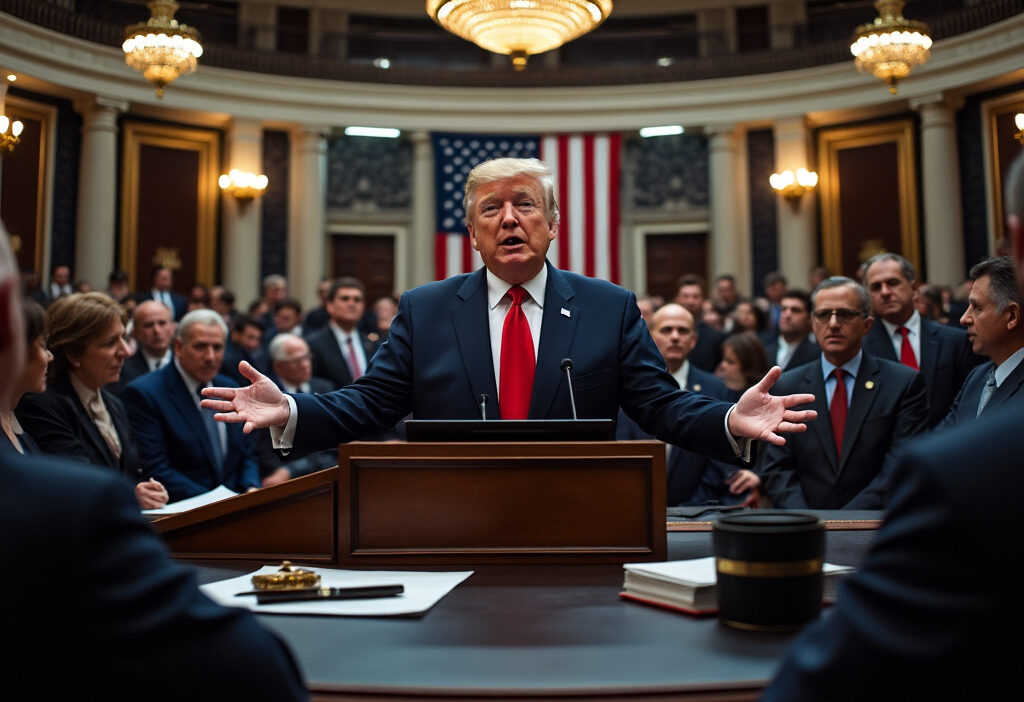House Passage of Trump’s Tax Bill A Comprehensive Overview
The House Republicans have narrowly passed President Trump’s ambitious tax and spending bill, marking a pivotal moment in his second-term legislative agenda. This article delves into the bill’s key provisions, the political dynamics surrounding its passage, and the challenges it faces in the Senate. Discover how this legislation could reshape American tax policy and federal spending.
The Genesis of Trump’s Tax Bill
The House passage of Trump’s tax bill marked a pivotal moment in his second-term agenda, securing a key GOP victory. The bill, now advancing to the Senate, builds on the 2017 Tax Cuts and Jobs Act while introducing new provisions. House Republicans rallied behind the legislation, framing it as a boon for middle-class families and small businesses. Democrats, however, criticized it as favoring corporations and high earners. The vote underscored deep partisan divides, with Republicans leveraging their slim majority to push the bill forward. Its Senate fate remains uncertain, hinging on negotiations and potential amendments. The bill’s progress reflects Trump’s enduring influence on GOP tax policy and sets the stage for broader economic debates.
Key Tax Cuts and Extensions
The House-passed version of Trump’s tax bill includes several key provisions aimed at reducing the tax burden for individuals and businesses. A central element is the permanent extension of the 2017 Tax Cuts and Jobs Act (TCJA), ensuring that individual tax brackets, the doubled standard deduction, and the expanded Child Tax Credit remain in place beyond their original expiration dates. This move seeks to provide long-term stability for taxpayers and prevent automatic tax hikes in the future.
Another notable provision is the tax exemption for tips and overtime income, designed to benefit service-industry workers and hourly employees. By shielding these earnings from federal taxes, the bill aims to boost take-home pay for millions of Americans in sectors like hospitality and retail. Additionally, the bill introduces new deductions for auto loan interest, allowing borrowers to write off a portion of their payments, which could ease financial pressure on middle-class families facing high vehicle costs.
These measures reflect the GOP’s broader goal of stimulating economic growth by putting more money back into taxpayers’ pockets. However, critics argue that the benefits skew toward higher earners and may exacerbate budget deficits. The Senate will now weigh these trade-offs as it debates the bill’s final form.
Impact on Wages and Families
The Trump tax bill’s passage in the House promises tangible financial relief for American families and workers. Projections suggest middle-class households could see an average annual tax cut of $1,600, with lower-income earners benefiting from expanded Child Tax Credits. For example, a family of four earning $75,000 may save $2,000 yearly due to adjusted brackets and deductions.
Workers stand to gain from provisions like the tax exemption on tips, potentially adding hundreds in take-home pay for service industry employees. A tipped worker earning $30,000 annually could save over $500. Additionally, overtime income tax relief may incentivize longer hours without penalizing higher earnings.
However, critics argue benefits skew toward higher earners, with corporate tax cuts potentially overshadowing individual savings. The bill’s long-term wage impact remains debated, though proponents cite projected GDP growth of 0.5% as a catalyst for broader income gains. These changes set the stage for the bill’s social provisions, linking tax policy to family-focused economic security.
Social and Economic Provisions
The Trump tax bill included several provisions aimed at bolstering family financial security through targeted social and economic measures. Education Savings Accounts (ESAs) were expanded, allowing families to use tax-advantaged 529 plans for K-12 expenses, including private school tuition—a move criticized for disproportionately benefiting wealthier households. The bill also introduced a paid family leave tax credit, offering employers a 12.5% to 25% credit for providing paid leave, though its voluntary nature limited widespread adoption.
For child care, the bill increased the Child Tax Credit (CTC) from $1,000 to $2,000 per child, with up to $1,400 refundable, but excluded undocumented immigrant families. Additionally, Health Savings Accounts (HSAs) saw contribution limits rise, enabling families to set aside more pre-tax dollars for medical expenses. Critics argued these measures favored higher earners, as lower-income families often lack the disposable income to maximize HSA contributions.
While proponents framed these changes as pro-family, their uneven accessibility raised concerns about widening economic disparities—a theme that dovetails with the bill’s broader spending reductions, explored next.
Spending Reductions and Entitlement Reforms
The Trump tax bill’s passage in the House included significant spending reductions for Medicaid and SNAP, reflecting GOP priorities to curb federal entitlement spending. Medicaid faced per-capita caps or block grants, shifting costs to states and potentially limiting coverage. SNAP reforms tightened eligibility, emphasizing work requirements. Proponents argued these changes would reduce dependency and encourage fiscal responsibility. Critics warned of disproportionate harm to low-income families and strained state budgets. The long-term implications could reshape safety net programs, aligning with broader conservative efforts to decentralize welfare policy. These cuts set the stage for contentious Senate debates, as seen in the narrow House vote ahead.
The House Vote Political Dynamics
The House vote on Trump’s tax bill was a tightly contested affair, passing 227-205 with 13 Republican dissenters, mostly from high-tax states like New York and New Jersey, who opposed the cap on state and local tax deductions. The narrow margin underscored internal GOP divisions, as leadership relied on last-minute negotiations to secure votes. Key holdouts, such as Rep. Leonard Lance (R-NJ), argued the bill disproportionately harmed their constituents. Meanwhile, the Freedom Caucus, initially skeptical, was swayed by promises of deeper spending cuts—tying into the broader entitlement reforms discussed earlier. The White House and Speaker Ryan employed aggressive whip operations, targeting vulnerable Republicans with assurances of future adjustments. This victory, however, sets up a tougher Senate battle, where the GOP’s slim majority leaves little room for error. The House’s success hinged on framing the bill as essential for economic growth, a theme Speaker Johnson would later amplify.
Speaker Johnson’s Perspective
House Speaker Mike Johnson hailed the passage of Trump’s tax bill as a historic turning point for American economic policy, framing it as a fulfillment of GOP promises to cut taxes and spur growth. In his remarks, Johnson emphasized the bill’s potential to boost middle-class incomes and simplify the tax code, aligning it with broader Republican priorities of deregulation and fiscal conservatism. He dismissed Democratic criticisms, arguing the legislation would unleash business investment and create jobs. The Speaker’s rhetoric underscored the GOP’s strategic pivot toward economic populism, leveraging the bill to energize the party’s base ahead of upcoming elections. However, his optimistic portrayal masked internal divisions, as some Republicans remained wary of the bill’s long-term fiscal impact. Johnson’s leadership in shepherding the bill through the House marked a significant victory, but the real test lay ahead in the Senate.
Challenges in the Senate
The bill now faces a steep climb in the Senate, where Republicans hold a slim majority and Democrats are unified in opposition. Key hurdles include reconciliation rules, which limit certain provisions, and potential defections from moderate GOP senators wary of the bill’s impact on deficits. Negotiations may force compromises, such as scaling back tax cuts for high earners or adjusting sunset clauses. Partisan tensions remain high, with Democrats decrying the bill as skewed toward corporations and the wealthy. The Senate’s unpredictable dynamics leave the bill’s final form—and even its passage—far from certain.
Public and Expert Reactions
The passage of the Trump tax bill in the House sparked polarized reactions. Proponents, including conservative economists and GOP leaders, hailed it as a long-overdue boost for businesses and middle-class families, arguing it would spur investment and job growth. Critics, however, warned of skyrocketing deficits and disproportionate benefits for corporations and the wealthy. Public opinion polls showed a divided electorate, with many Americans skeptical of the bill’s promised trickle-down effects.
Economists were similarly split. Some praised the corporate tax cut as a competitive necessity, while others cautioned it would widen income inequality. Political analysts noted the bill’s rushed process fueled accusations of partisanship, with Democrats decrying its lack of bipartisan input. Advocacy groups, like the AARP, raised concerns over potential cuts to social programs to offset revenue losses.
The debate foreshadowed the Senate’s contentious path ahead, where lingering disagreements over deductions and deficits threatened to reshape the bill further.
Looking Ahead The Road to Implementation
With the House’s approval secured, the Trump tax bill now faces a critical hurdle in the Senate, where its fate hinges on narrow Republican margins and procedural challenges. The Senate must reconcile its version with the House bill, addressing key differences in individual tax brackets, corporate rates, and deficit projections. Given the GOP’s slim majority, every vote counts—particularly from moderates concerned about fiscal impacts and populists pushing for deeper cuts.
The timeline remains tight, with Republican leadership aiming for passage before year-end. However, potential roadblocks include Byrd Rule constraints, which could force last-minute revisions to comply with budget reconciliation rules. Lobbying efforts will intensify as industries and advocacy groups push for adjustments, while public scrutiny grows over provisions favoring high earners.
If the Senate passes its version, a conference committee will negotiate a final compromise. Once both chambers approve the unified bill, it heads to the White House for Trump’s signature. Implementation would then fall to the IRS and Treasury, requiring rapid updates to withholding tables and regulatory guidance. The bill’s long-term impact will depend on economic conditions, midterm elections, and potential future legislative tweaks.

Conclusions
The House passage of Trump’s tax bill represents a significant Republican achievement, aiming to cement and expand tax cuts while reducing federal spending. However, its future remains uncertain as it heads to the Senate. This legislation could profoundly impact American families and the economy, but its success hinges on navigating political challenges and public scrutiny.



